Business and Corporation Law - Negligence: Case Study and Defenses
VerifiedAdded on 2022/10/02
|6
|1256
|139
Report
AI Summary
This report provides a comprehensive analysis of negligence within the framework of business and corporation law. It begins by defining negligence as a civil wrong and outlines the essential elements required to establish a claim, including duty of care, breach of duty, causation, and damages. The report references the Wrongs Act 1958 (Vic) and the landmark case of Donoghue v Stevenson to illustrate the principles of negligence and the concept of duty of care. A case study involving a supermarket customer, Kyle, who slips on a grape, is then analyzed to determine the applicability of negligence principles. The report concludes by examining potential defenses against a negligence claim, specifically contributory negligence, and discusses the admissibility of a manager's apology as an admission of liability. The analysis integrates legal principles with practical application, providing a clear understanding of negligence in a business context.
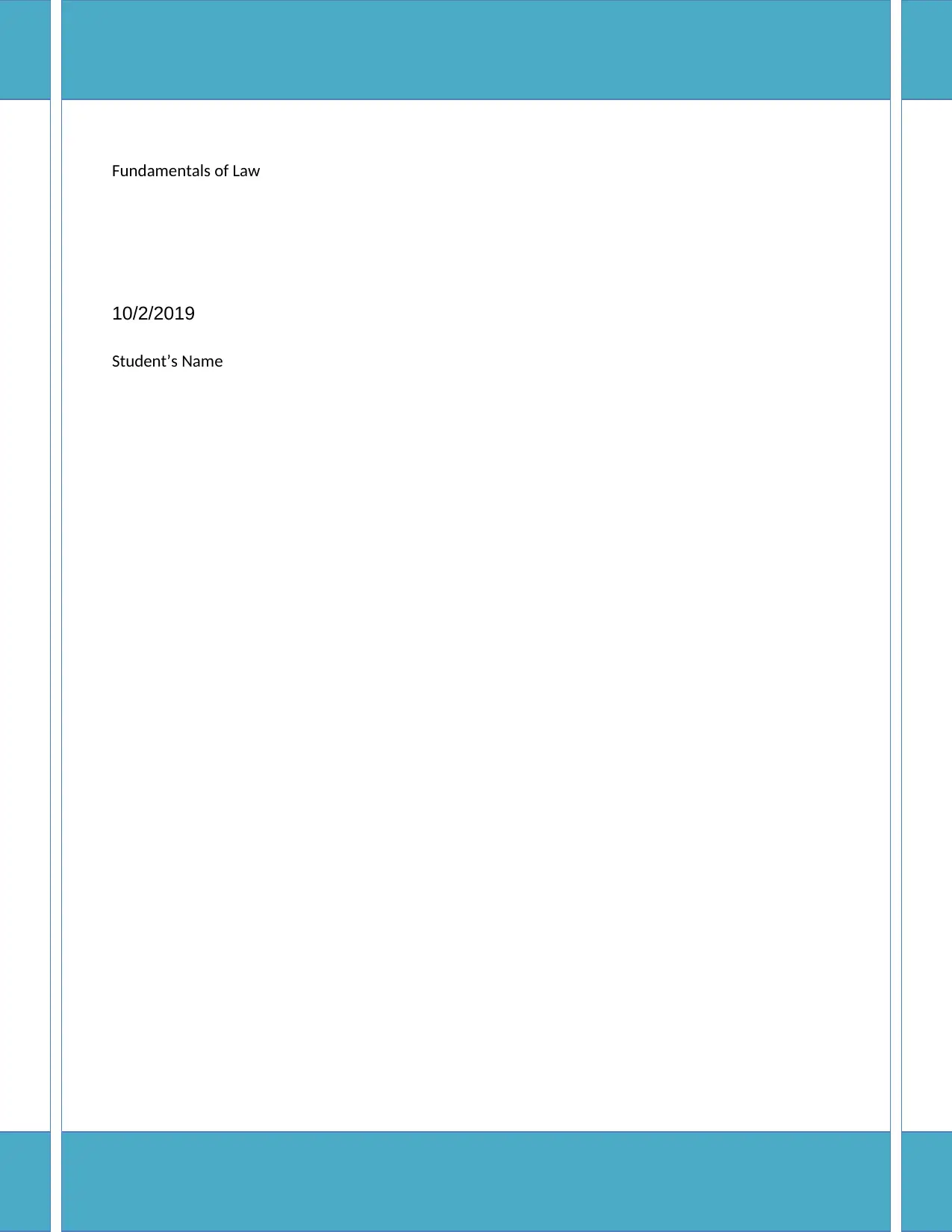
Running Head: BUSINESS AND CORPORATION LAW 0
Fundamentals of Law
10/2/2019
Student’s Name
Fundamentals of Law
10/2/2019
Student’s Name
Paraphrase This Document
Need a fresh take? Get an instant paraphrase of this document with our AI Paraphraser
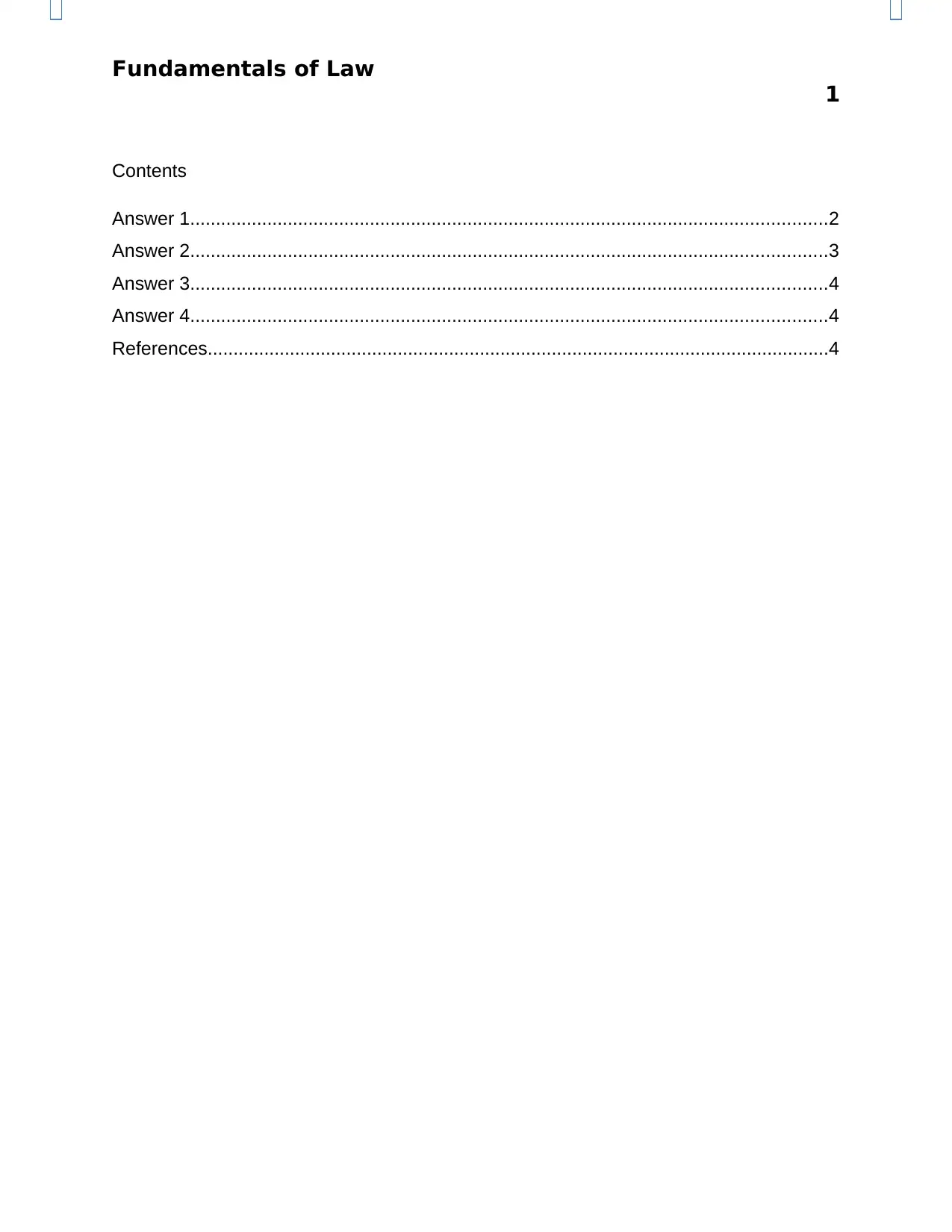
Fundamentals of Law
1
Contents
Answer 1............................................................................................................................2
Answer 2............................................................................................................................3
Answer 3............................................................................................................................4
Answer 4............................................................................................................................4
References.........................................................................................................................4
1
Contents
Answer 1............................................................................................................................2
Answer 2............................................................................................................................3
Answer 3............................................................................................................................4
Answer 4............................................................................................................................4
References.........................................................................................................................4
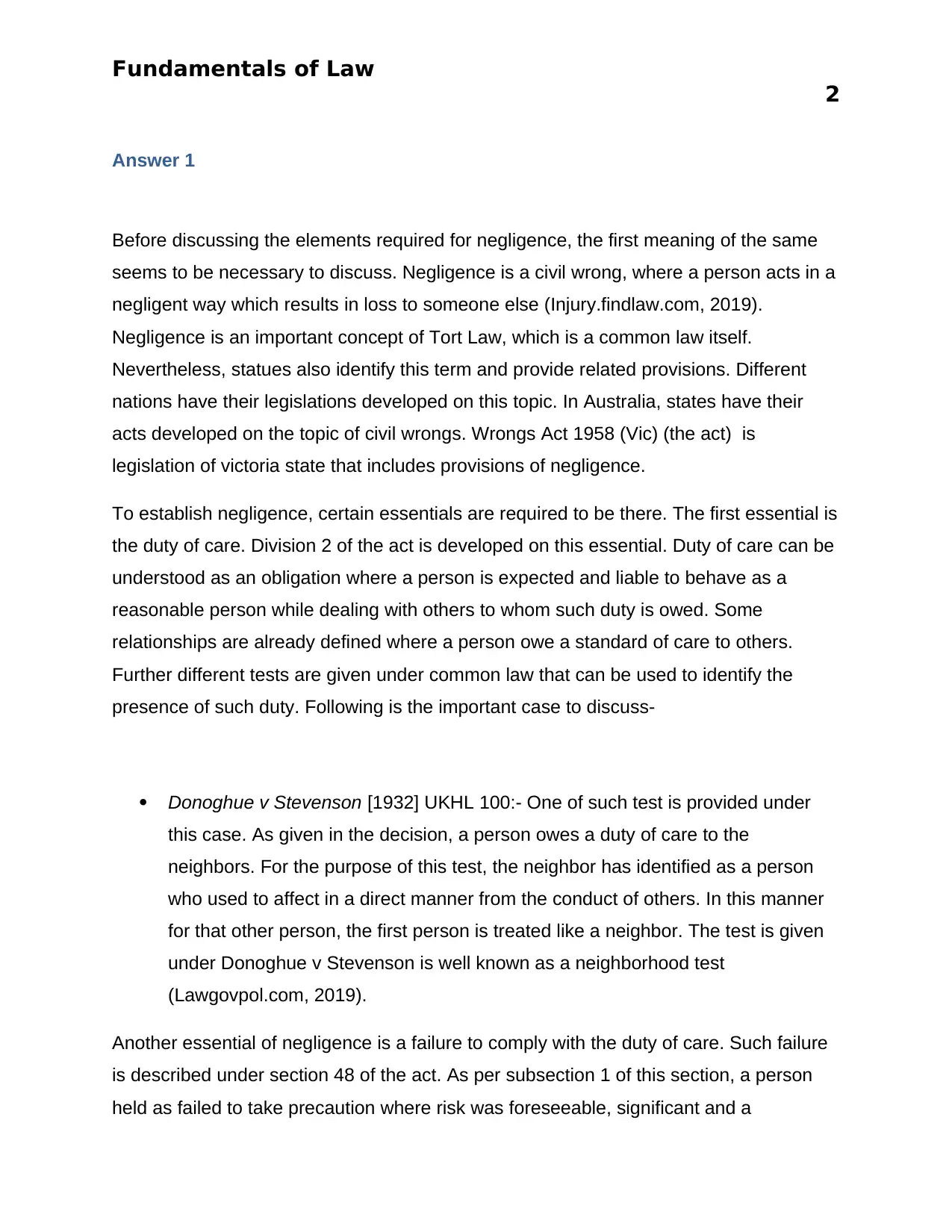
Fundamentals of Law
2
Answer 1
Before discussing the elements required for negligence, the first meaning of the same
seems to be necessary to discuss. Negligence is a civil wrong, where a person acts in a
negligent way which results in loss to someone else (Injury.findlaw.com, 2019).
Negligence is an important concept of Tort Law, which is a common law itself.
Nevertheless, statues also identify this term and provide related provisions. Different
nations have their legislations developed on this topic. In Australia, states have their
acts developed on the topic of civil wrongs. Wrongs Act 1958 (Vic) (the act) is
legislation of victoria state that includes provisions of negligence.
To establish negligence, certain essentials are required to be there. The first essential is
the duty of care. Division 2 of the act is developed on this essential. Duty of care can be
understood as an obligation where a person is expected and liable to behave as a
reasonable person while dealing with others to whom such duty is owed. Some
relationships are already defined where a person owe a standard of care to others.
Further different tests are given under common law that can be used to identify the
presence of such duty. Following is the important case to discuss-
Donoghue v Stevenson [1932] UKHL 100:- One of such test is provided under
this case. As given in the decision, a person owes a duty of care to the
neighbors. For the purpose of this test, the neighbor has identified as a person
who used to affect in a direct manner from the conduct of others. In this manner
for that other person, the first person is treated like a neighbor. The test is given
under Donoghue v Stevenson is well known as a neighborhood test
(Lawgovpol.com, 2019).
Another essential of negligence is a failure to comply with the duty of care. Such failure
is described under section 48 of the act. As per subsection 1 of this section, a person
held as failed to take precaution where risk was foreseeable, significant and a
2
Answer 1
Before discussing the elements required for negligence, the first meaning of the same
seems to be necessary to discuss. Negligence is a civil wrong, where a person acts in a
negligent way which results in loss to someone else (Injury.findlaw.com, 2019).
Negligence is an important concept of Tort Law, which is a common law itself.
Nevertheless, statues also identify this term and provide related provisions. Different
nations have their legislations developed on this topic. In Australia, states have their
acts developed on the topic of civil wrongs. Wrongs Act 1958 (Vic) (the act) is
legislation of victoria state that includes provisions of negligence.
To establish negligence, certain essentials are required to be there. The first essential is
the duty of care. Division 2 of the act is developed on this essential. Duty of care can be
understood as an obligation where a person is expected and liable to behave as a
reasonable person while dealing with others to whom such duty is owed. Some
relationships are already defined where a person owe a standard of care to others.
Further different tests are given under common law that can be used to identify the
presence of such duty. Following is the important case to discuss-
Donoghue v Stevenson [1932] UKHL 100:- One of such test is provided under
this case. As given in the decision, a person owes a duty of care to the
neighbors. For the purpose of this test, the neighbor has identified as a person
who used to affect in a direct manner from the conduct of others. In this manner
for that other person, the first person is treated like a neighbor. The test is given
under Donoghue v Stevenson is well known as a neighborhood test
(Lawgovpol.com, 2019).
Another essential of negligence is a failure to comply with the duty of care. Such failure
is described under section 48 of the act. As per subsection 1 of this section, a person
held as failed to take precaution where risk was foreseeable, significant and a
⊘ This is a preview!⊘
Do you want full access?
Subscribe today to unlock all pages.

Trusted by 1+ million students worldwide
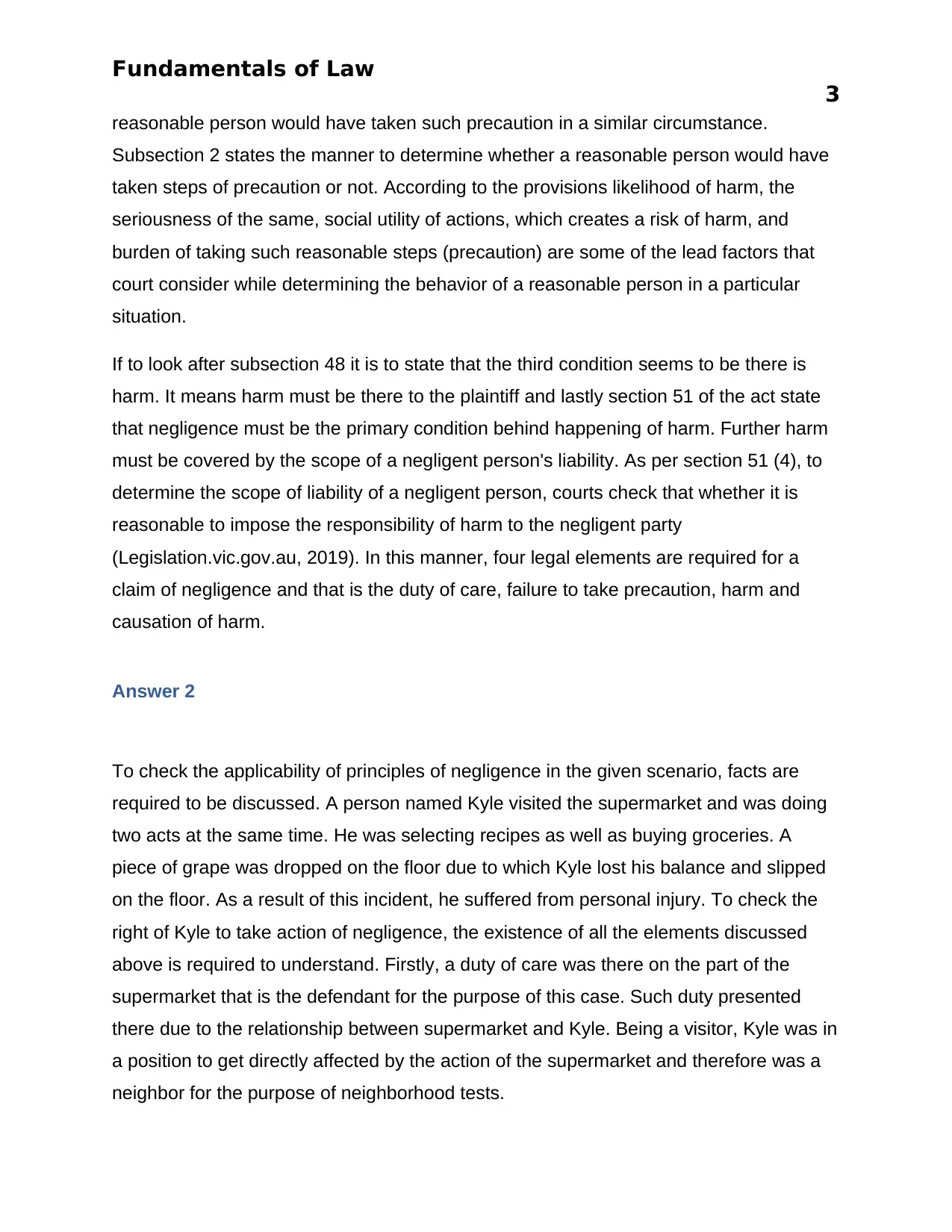
Fundamentals of Law
3
reasonable person would have taken such precaution in a similar circumstance.
Subsection 2 states the manner to determine whether a reasonable person would have
taken steps of precaution or not. According to the provisions likelihood of harm, the
seriousness of the same, social utility of actions, which creates a risk of harm, and
burden of taking such reasonable steps (precaution) are some of the lead factors that
court consider while determining the behavior of a reasonable person in a particular
situation.
If to look after subsection 48 it is to state that the third condition seems to be there is
harm. It means harm must be there to the plaintiff and lastly section 51 of the act state
that negligence must be the primary condition behind happening of harm. Further harm
must be covered by the scope of a negligent person's liability. As per section 51 (4), to
determine the scope of liability of a negligent person, courts check that whether it is
reasonable to impose the responsibility of harm to the negligent party
(Legislation.vic.gov.au, 2019). In this manner, four legal elements are required for a
claim of negligence and that is the duty of care, failure to take precaution, harm and
causation of harm.
Answer 2
To check the applicability of principles of negligence in the given scenario, facts are
required to be discussed. A person named Kyle visited the supermarket and was doing
two acts at the same time. He was selecting recipes as well as buying groceries. A
piece of grape was dropped on the floor due to which Kyle lost his balance and slipped
on the floor. As a result of this incident, he suffered from personal injury. To check the
right of Kyle to take action of negligence, the existence of all the elements discussed
above is required to understand. Firstly, a duty of care was there on the part of the
supermarket that is the defendant for the purpose of this case. Such duty presented
there due to the relationship between supermarket and Kyle. Being a visitor, Kyle was in
a position to get directly affected by the action of the supermarket and therefore was a
neighbor for the purpose of neighborhood tests.
3
reasonable person would have taken such precaution in a similar circumstance.
Subsection 2 states the manner to determine whether a reasonable person would have
taken steps of precaution or not. According to the provisions likelihood of harm, the
seriousness of the same, social utility of actions, which creates a risk of harm, and
burden of taking such reasonable steps (precaution) are some of the lead factors that
court consider while determining the behavior of a reasonable person in a particular
situation.
If to look after subsection 48 it is to state that the third condition seems to be there is
harm. It means harm must be there to the plaintiff and lastly section 51 of the act state
that negligence must be the primary condition behind happening of harm. Further harm
must be covered by the scope of a negligent person's liability. As per section 51 (4), to
determine the scope of liability of a negligent person, courts check that whether it is
reasonable to impose the responsibility of harm to the negligent party
(Legislation.vic.gov.au, 2019). In this manner, four legal elements are required for a
claim of negligence and that is the duty of care, failure to take precaution, harm and
causation of harm.
Answer 2
To check the applicability of principles of negligence in the given scenario, facts are
required to be discussed. A person named Kyle visited the supermarket and was doing
two acts at the same time. He was selecting recipes as well as buying groceries. A
piece of grape was dropped on the floor due to which Kyle lost his balance and slipped
on the floor. As a result of this incident, he suffered from personal injury. To check the
right of Kyle to take action of negligence, the existence of all the elements discussed
above is required to understand. Firstly, a duty of care was there on the part of the
supermarket that is the defendant for the purpose of this case. Such duty presented
there due to the relationship between supermarket and Kyle. Being a visitor, Kyle was in
a position to get directly affected by the action of the supermarket and therefore was a
neighbor for the purpose of neighborhood tests.
Paraphrase This Document
Need a fresh take? Get an instant paraphrase of this document with our AI Paraphraser
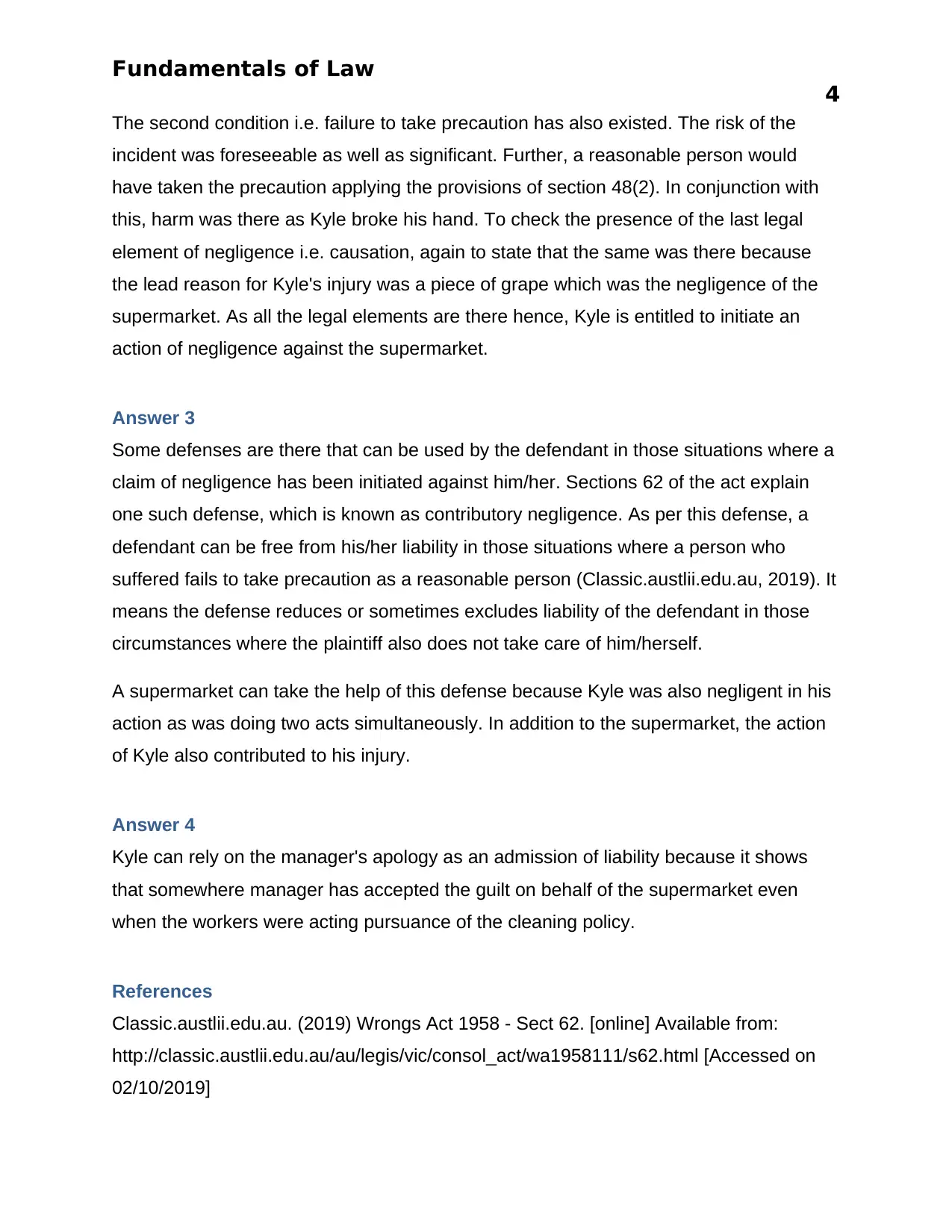
Fundamentals of Law
4
The second condition i.e. failure to take precaution has also existed. The risk of the
incident was foreseeable as well as significant. Further, a reasonable person would
have taken the precaution applying the provisions of section 48(2). In conjunction with
this, harm was there as Kyle broke his hand. To check the presence of the last legal
element of negligence i.e. causation, again to state that the same was there because
the lead reason for Kyle's injury was a piece of grape which was the negligence of the
supermarket. As all the legal elements are there hence, Kyle is entitled to initiate an
action of negligence against the supermarket.
Answer 3
Some defenses are there that can be used by the defendant in those situations where a
claim of negligence has been initiated against him/her. Sections 62 of the act explain
one such defense, which is known as contributory negligence. As per this defense, a
defendant can be free from his/her liability in those situations where a person who
suffered fails to take precaution as a reasonable person (Classic.austlii.edu.au, 2019). It
means the defense reduces or sometimes excludes liability of the defendant in those
circumstances where the plaintiff also does not take care of him/herself.
A supermarket can take the help of this defense because Kyle was also negligent in his
action as was doing two acts simultaneously. In addition to the supermarket, the action
of Kyle also contributed to his injury.
Answer 4
Kyle can rely on the manager's apology as an admission of liability because it shows
that somewhere manager has accepted the guilt on behalf of the supermarket even
when the workers were acting pursuance of the cleaning policy.
References
Classic.austlii.edu.au. (2019) Wrongs Act 1958 - Sect 62. [online] Available from:
http://classic.austlii.edu.au/au/legis/vic/consol_act/wa1958111/s62.html [Accessed on
02/10/2019]
4
The second condition i.e. failure to take precaution has also existed. The risk of the
incident was foreseeable as well as significant. Further, a reasonable person would
have taken the precaution applying the provisions of section 48(2). In conjunction with
this, harm was there as Kyle broke his hand. To check the presence of the last legal
element of negligence i.e. causation, again to state that the same was there because
the lead reason for Kyle's injury was a piece of grape which was the negligence of the
supermarket. As all the legal elements are there hence, Kyle is entitled to initiate an
action of negligence against the supermarket.
Answer 3
Some defenses are there that can be used by the defendant in those situations where a
claim of negligence has been initiated against him/her. Sections 62 of the act explain
one such defense, which is known as contributory negligence. As per this defense, a
defendant can be free from his/her liability in those situations where a person who
suffered fails to take precaution as a reasonable person (Classic.austlii.edu.au, 2019). It
means the defense reduces or sometimes excludes liability of the defendant in those
circumstances where the plaintiff also does not take care of him/herself.
A supermarket can take the help of this defense because Kyle was also negligent in his
action as was doing two acts simultaneously. In addition to the supermarket, the action
of Kyle also contributed to his injury.
Answer 4
Kyle can rely on the manager's apology as an admission of liability because it shows
that somewhere manager has accepted the guilt on behalf of the supermarket even
when the workers were acting pursuance of the cleaning policy.
References
Classic.austlii.edu.au. (2019) Wrongs Act 1958 - Sect 62. [online] Available from:
http://classic.austlii.edu.au/au/legis/vic/consol_act/wa1958111/s62.html [Accessed on
02/10/2019]
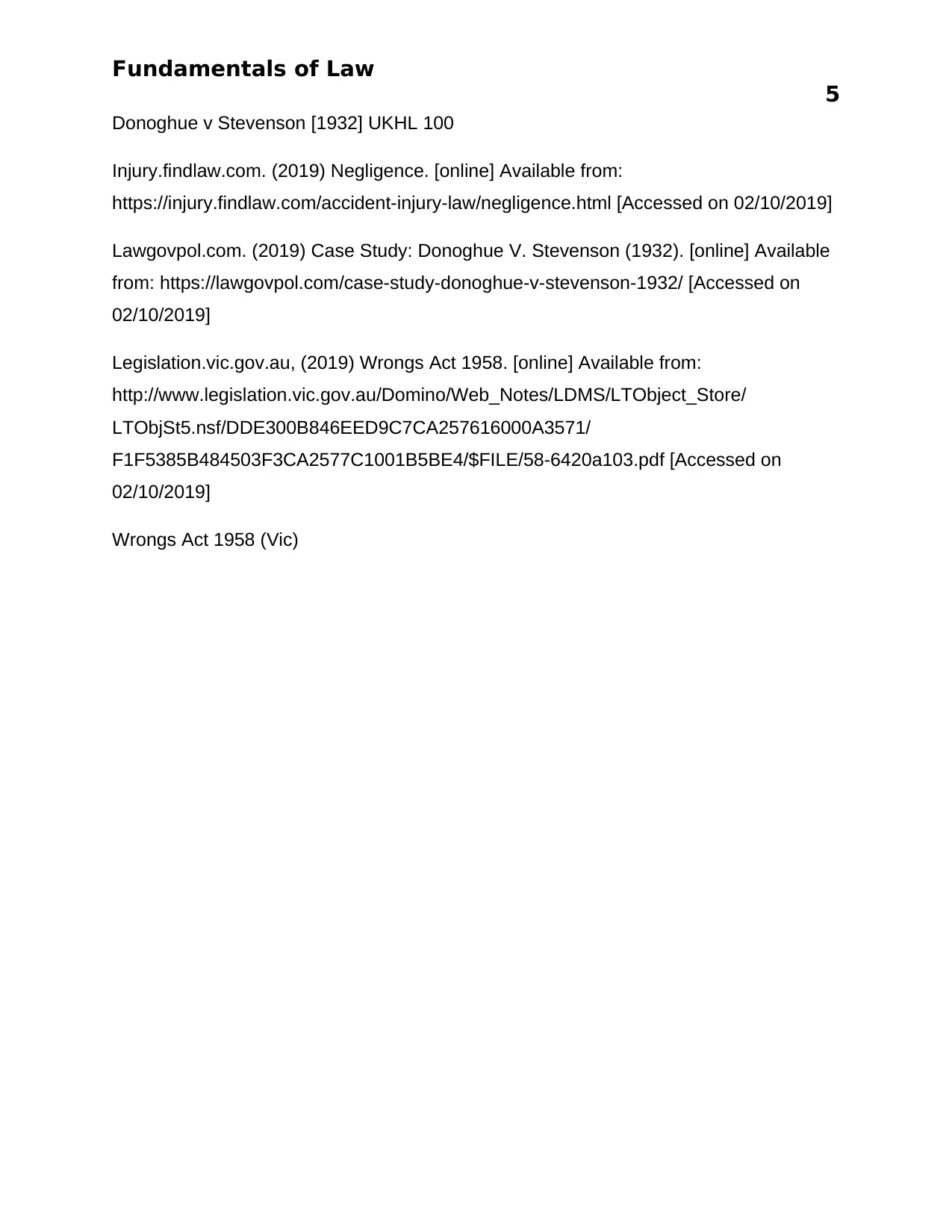
Fundamentals of Law
5
Donoghue v Stevenson [1932] UKHL 100
Injury.findlaw.com. (2019) Negligence. [online] Available from:
https://injury.findlaw.com/accident-injury-law/negligence.html [Accessed on 02/10/2019]
Lawgovpol.com. (2019) Case Study: Donoghue V. Stevenson (1932). [online] Available
from: https://lawgovpol.com/case-study-donoghue-v-stevenson-1932/ [Accessed on
02/10/2019]
Legislation.vic.gov.au, (2019) Wrongs Act 1958. [online] Available from:
http://www.legislation.vic.gov.au/Domino/Web_Notes/LDMS/LTObject_Store/
LTObjSt5.nsf/DDE300B846EED9C7CA257616000A3571/
F1F5385B484503F3CA2577C1001B5BE4/$FILE/58-6420a103.pdf [Accessed on
02/10/2019]
Wrongs Act 1958 (Vic)
5
Donoghue v Stevenson [1932] UKHL 100
Injury.findlaw.com. (2019) Negligence. [online] Available from:
https://injury.findlaw.com/accident-injury-law/negligence.html [Accessed on 02/10/2019]
Lawgovpol.com. (2019) Case Study: Donoghue V. Stevenson (1932). [online] Available
from: https://lawgovpol.com/case-study-donoghue-v-stevenson-1932/ [Accessed on
02/10/2019]
Legislation.vic.gov.au, (2019) Wrongs Act 1958. [online] Available from:
http://www.legislation.vic.gov.au/Domino/Web_Notes/LDMS/LTObject_Store/
LTObjSt5.nsf/DDE300B846EED9C7CA257616000A3571/
F1F5385B484503F3CA2577C1001B5BE4/$FILE/58-6420a103.pdf [Accessed on
02/10/2019]
Wrongs Act 1958 (Vic)
⊘ This is a preview!⊘
Do you want full access?
Subscribe today to unlock all pages.

Trusted by 1+ million students worldwide
1 out of 6
Related Documents
Your All-in-One AI-Powered Toolkit for Academic Success.
+13062052269
info@desklib.com
Available 24*7 on WhatsApp / Email
![[object Object]](/_next/static/media/star-bottom.7253800d.svg)
Unlock your academic potential
Copyright © 2020–2025 A2Z Services. All Rights Reserved. Developed and managed by ZUCOL.





